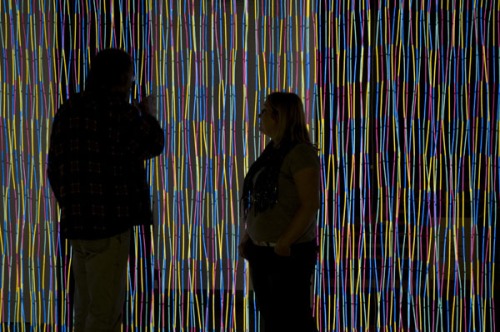Simon Fenoulhet “Lucent Lines” Newport Museum and Art Gallery
Simon Fenoulhet creates installations made of mass produced objects that are often in themselves mundane and pretty uninteresting – In past works he has used teaspoons, bits of plastic, ping pong balls and old furniture.
For this exhibition he’s appropriated drinking straws, bootlaces and plumbers piping and brought it to life with the key element of many of his works: light.
The main piece here consists of a wire curtain suspended from the gallery ceiling.
Strands of light emitting wire are threaded through with coloured drinking straws that subtly modify the light coming from them. Hidden out of view is a sophisticated computer driven box of tricks that essentially switches the wires on and off in sequence – a bit like those chasing lights on a Christmas tree – so that moving patterns flash across the surface of the curtain.
The effect, in a darkened gallery, is disarmingly simple. Despite the technological complexity there’s an uncomplicated purity to the piece. The mechanics are kept neatly out of sight – a good decision – you don’t need to know how a phone works to understand the simple pleasure of communicating with someone a hundred miles away. It just works.
Fenoulhet has certainly succeeded in creating something popular and engaging.
Perhaps it’s the darkness of the room that is affecting the usual hushed gallery atmosphere, or maybe the anonymity from being able to hide in the shadows but it’s not often you get the kind of whoops and cries of “lush” from gangs of teenage girls when confronted with contemporary art installation.
I’m sure much of this is down to the element of movement in the piece. Fenoulhet has based the patterns of movement on algorithms derived from studying the light on water and on clouds moving through the sky. David Hockney once noted that we seem to have lost the ability to look for any length of time at still images – he blamed television. But motion is hypnotic and demands attention, it must be somehow hard-wired into the human brain – which is perhaps why people sit and stare at the sea for hours – whereas stillness can be easily overlooked.
Which might explain why the other two, much more static, pieces on show here definitely weren’t holding the casual viewers attention for the same time span.
In Line Upon Line a simple rectangle of light is projected over a series of parallel lines on the wall. The lines are boot laces. And, as you wait for the carousel of the projector to tick to the next slide (it doesn’t) you start to notice slight movements and colours on the screen, this is just the eye playing tricks as Fenoulhet has carefully manipulated the distance and contrast between the lines. It’s interesting, like the optical illusions they used to print in comics but some may possibly find it just too slight and too ephemeral.
In the third piece Hollow Promise, a row of white plumbers piping augmented with red lights lies across the floor. Again, it’s deceptively simple and pleasant enough in a 1970’s minimalist/Zen like way.
To be honest I’ve seen just as subtle and clever things done with lighting in commercial architectural spaces – or even Blackpool sea front – but that might be missing the point if there’s one thing Fenoulhet understands as much as light, it’s the importance of gallery context.
(A shorter version of this review appeared in The Western Mail 12.02.10)
Filed under: Reviews | 1 Comment
Tags: Art, Installation, Newport, review, Simon Fenoulhet, Wales, Western Mail


One Response to “Simon Fenoulhet “Lucent Lines” Newport Museum and Art Gallery”